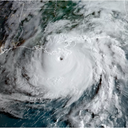NOAA predicts as many as 6 major Atlantic hurricanes in unusually active season

The upcoming Atlantic hurricane season is likely to be unusually active, according to the National Oceanic and Atmospheric Administration's hurricane season outlook released Tuesday.
Why it matters: Hurricanes are nature's most destructive storms, and if this forecast proves accurate, this would be the seventh straight year of above average activity.
- The past two hurricane seasons both exhausted the list of 21 storm names, which was unprecedented. The 2020 season was the most active on record.
The big picture: NOAA is forecasting a 65% chance that the upcoming hurricane season will be above average, with a 25% chance of near normal activity and just a 10% chance of below normal tropical cyclone numbers.
- In terms of the number of storms, the agency is predicting a 70% chance of 14 to 21 named storms. Of these, six to 10 would become hurricanes, and of these, three to six would intensify into major hurricanes of Category 3 or greater.
- A typical Atlantic hurricane season has 14 named storms, seven hurricanes and three major hurricanes, according to the National Hurricane Center.
Context: NOAA is basing its forecast on several factors, including sea surface temperatures in the North Atlantic Ocean Basin and the presence of a La Niña event in the tropical Pacific Ocean.
- La Niña is characterized by cooler than average waters near the equator, and it can reduce the winds in the middle and upper atmosphere all the way to the Atlantic.
- These weaker winds can encourage hurricane development by reducing wind shear, which can tear nascent storms apart.
- Climate studies show that increasing ocean and air temperatures are leading to wetter, stronger hurricanes, and that rapidly intensifying storms, such as Hurricane Ida last year, are more likely today than just a few decades ago.
- Hurricane forecasters also took into account the presence of warmer-than-average sea surface temperatures in the Atlantic Ocean and Caribbean Sea, along an enhanced west African monsoon. The monsoon can give rise to groups of thunderstorms moving off the west coast of Africa, that then go on to form tropical storms and hurricanes.
Of note: While the season has not kicked off yet (that happens June 1), some forecasters have raised concerns over an area of unusually mild water temperatures in the Gulf of Mexico.
- Known as the Gulf of Mexico loop current, if storms were to form in that region or traverse the current, they could rapidly grow into powerful storms.
Threat level: The greatest threat to life from tropical storms and hurricanes is inland flooding, as shown by Hurricane Ida, which killed more people in the northern Mid-Atlantic from flash floods than it did along the Gulf Coast, where it made landfall.
- Top NOAA, New York City and FEMA officials emphasized this by briefing on the outlook from New York City Emergency Management Department in Brooklyn.
- "I want New Yorkers to be ready," said New York City Mayor Eric Adams.